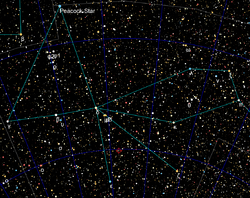Astronomy:HD 186302
From HandWiki
Short description: Star in the constellation Pavo
| Observation data Equinox J2000.0]] (ICRS) | |
|---|---|
| Constellation | Pavo |
| Right ascension | 19h 49m 06.43036s[1] |
| Declination | −70° 11′ 16.7033″[1] |
| Apparent magnitude (V) | 8.76±0.01[2] |
| Characteristics | |
| Spectral type | G3/5 V[3] |
| B−V color index | 0.67[4] |
| Astrometry | |
| Radial velocity (Rv) | −1.3±0.3[5] km/s |
| Proper motion (μ) | RA: −24.004[1] mas/yr Dec.: −38.804[1] mas/yr |
| Parallax (π) | 17.6309 ± 0.0147[1] mas |
| Distance | 185.0 ± 0.2 ly (56.72 ± 0.05 pc) |
| Absolute magnitude (MV) | +5.11[6] |
| Details[7] | |
| Mass | 0.97±0.01 M☉ |
| Radius | 0.95±0.01 R☉ |
| Surface gravity (log g) | 4.47±0.01 cgs |
| Temperature | 5,675±15 K |
| Metallicity [Fe/H] | −0.03[8] dex |
| Rotational velocity (v sin i) | 2.30[8] km/s |
| Age | 4.5±0.81 Gyr |
| Other designations | |
HD 186302, HIP 97507, 2MASS J19490644-7011167, CD−70°1724 | |
| Database references | |
| SIMBAD | data |
HD 186302 (also designated HIP 97507)[9] is a star in the constellation of Pavo. It is 185 light-years (57 parsecs) away from Earth, with an apparent magnitude of 8.76.[9] It was identified in November 2018 as a potential solar sibling to the Sun. Similar by spectrum and size, it was suspected to have formed in the same stellar nursery as the Sun 4.6 billion years ago.[10] Common origin with Sun was found to be unlikely in a 2019 paper, as HD 186302's galactic orbit is very different from Sun's.[11]
See also
References
- ↑ 1.0 1.1 1.2 1.3 1.4 Vallenari, A. et al. (2022). "Gaia Data Release 3. Summary of the content and survey properties". Astronomy & Astrophysics. doi:10.1051/0004-6361/202243940 Gaia DR3 record for this source at VizieR.
- ↑ Høg, E.; Fabricius, C.; Makarov, V. V.; Urban, S.; Corbin, T.; Wycoff, G.; Bastian, U.; Schwekendiek, P. et al. (March 2000). "The Tycho-2 catalogue of the 2.5 million brightest stars". Astronomy and Astrophysics 355: L27–L30. ISSN 0004-6361. Bibcode: 2000A&A...355L..27H.
- ↑ Houk, N.; Cowley, A. P. (1975). University of Michigan Catalogue of two-dimensional spectral types for the HD stars. Volume I. Declinations −90° to −53°. Bibcode: 1975mcts.book.....H.
- ↑ Gomes Da Silva, J.; Santos, N. C.; Adibekyan, V.; Sousa, S. G.; Campante, T. L.; Figueira, P.; Bossini, D.; Delgado-Mena, E. et al. (2021). "Stellar chromospheric activity of 1674 FGK stars from the AMBRE-HARPS sample. I. A catalogue of homogeneous chromospheric activity". Astronomy and Astrophysics 646: A77. doi:10.1051/0004-6361/202039765. Bibcode: 2021A&A...646A..77G.
- ↑ Gontcharov, G. A. (November 2006). "Pulkovo Compilation of Radial Velocities for 35,495 Hipparcos stars in a common system". Astronomy Letters 32 (11): 759–771. doi:10.1134/S1063773706110065. ISSN 1063-7737. Bibcode: 2006AstL...32..759G.
- ↑ Anderson, E.; Francis, Ch. (May 2012). "XHIP: An extended hipparcos compilation". Astronomy Letters 38 (5): 331–346. doi:10.1134/S1063773712050015. ISSN 1063-7737. Bibcode: 2012AstL...38..331A.
- ↑ Adibekyan, V.; De Laverny, P.; Recio-Blanco, A.; Sousa, S. G.; Delgado-Mena, E.; Kordopatis, G.; Ferreira, A. C. S.; Santos, N. C. et al. (2018). "The AMBRE project: Searching for the closest solar siblings". Astronomy and Astrophysics 619: A130. doi:10.1051/0004-6361/201834285. Bibcode: 2018A&A...619A.130A.
- ↑ 8.0 8.1 Llorente de Andrés, F.; Chavero, C.; de la Reza, R.; Roca-Fàbrega, S.; Cifuentes, C. (October 2021). "The evolution of lithium in FGK dwarf stars". Astronomy & Astrophysics 654: A137. doi:10.1051/0004-6361/202141339. ISSN 0004-6361. Bibcode: 2021A&A...654A.137L.
- ↑ 9.0 9.1 "HD 186302". SIMBAD. Centre de données astronomiques de Strasbourg. http://simbad.u-strasbg.fr/simbad/sim-basic?Ident=HD+186302.
- ↑ Matt Williams (2018-11-21). "Astronomers Find One of the Sun's Sibling Stars. Born From the Same Solar Nebula Billions of Years Ago". https://www.universetoday.com/140598/astronomers-find-one-of-the-suns-sibling-stars-born-from-the-same-solar-nebula-billion-of-years-ago/.
- ↑ Leung, Henry W.; MacKereth, J Ted; Hunt, Jason A S.; Portegies Zwart, Simon; Bovy, Jo; Price-Jones, Natalie; Webb, Jeremy J. (2020). "Searching for solar siblings in APOGEE and Gaia DR2 with N-body simulations". Monthly Notices of the Royal Astronomical Society 494 (2): 2268–2279. doi:10.1093/mnras/staa788. Bibcode: 2020MNRAS.494.2268W.
- ↑ Batista, S. F. A.; Adibekyan, V. Zh.; Sousa, S. G.; Santos, N. C.; Delgado Mena, E.; Hakobyan, A. A. (2014), "Searching for solar siblings among the HARPS data", Astronomy & Astrophysics 564: A43, doi:10.1051/0004-6361/201423645, Bibcode: 2014A&A...564A..43B
 |


